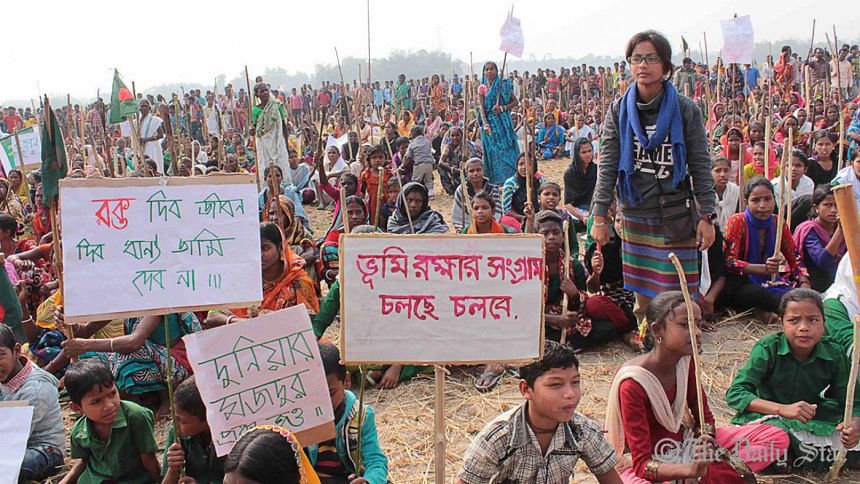Addressing the land question

In a developing country such as Bangladesh, where the implementation of democracy still seems a far flung dream as national budgets blur the line between fantasy and expectation, land has come to be the defining issue of the day. It is of little surprise that a third-world country, caught in the throes of frantic industrial development, would have to deal with the issue of land. Add to it the fact that Bangladesh is the most densely populated country in the world and what you basically have is a recipe for development induced disasters. But even taking all of these challenges into account the current state of land rights in the country is appalling. Almost 56 percent of the entire population is functionally landless, getting by either through odd jobs or becoming part of the industrial division of labour. The average size of land holding is a meagre 0.6 hectare. For a country that is yet almost completely dependent on agrarianism as part of its economy, that is a terrible figure.
A quick look at the rampant corporatism in the acquisition and use of land will tell us where the root of the problems lie. A 1950 law states that no corporation or household is allowed to own more 33.33 acres of land by itself. While this law itself seems to have been made with the region's low availability of land in mind, it falls flat in the face of bureaucratic capitalism. An investor can now easily create dummy firms and corporations under whose name they can own an unlimited amount of land, all registered under different firms or people. This is why we see thousands upon thousands of acres of land owned by giant firms, while the poorest are becoming increasingly dispossessed of land and livelihood.
The question of land extends far beyond the scope of acquisition. In many parts of the country, some yet to be transformed by the mechanisms of for-profit businesses, land forms an intrinsic part of a community's identity. Often the land on which people farm has been passed down through the generations, and is used to grow crops, house the dead and for festivals and the likes. Is there a monetary value that can be placed on such a relationship? The answer to that might be no, but the government does seem intent on trying its best to do so. A nation gripped by the rhetoric of development, Bangladesh is now site to several contested regions where displacement is occurring every day.
Yours truly has visited several of these sites- Rampal in Bagerhat, Chunarughat in Habiganj, Banshkhali in Chittagong. In all of these cases, displacement either has occurred or will occur due to development projects. In the case of Rampal, the land acquisition for the coal-power plant has already displaced thousands. Where there was once fields of fish farms and crops, there are now trucks carrying sand as the Sundarbans wait apprehensively for a death blow. A fact-finding mission has revealed that the government had absolutely no safeguards in place for the displacement that happened there. They only offered monetary compensation for the land, and even that below market price. The government knowingly flouted several rules from institutions such as World Bank and Asian Development Bank (ADB) for Development-Induced Displacement (DIDR). That is, when a government removes a people from their land in order to make way for some infrastructural development, they must not only compensate but also rehabilitate, make sure that these people have a new area of living, and a secure means of living. Instead, the government chose to only pay the value of the land and move on. Not looking at the population who were landless on paper, who were evicted and got nothing in return. These people, along with the ones who received compensation, will eventually fill garments factories and chemical factories, having no choice but to enter the labour supply- thereby fundamentally changing their way of life without their consent. The only law the government has to go by is the Acquisition and Requisition of Immovable Property Act 1984, which is probably one of the laziest examples of lawmaking. In a legislation that is almost copied word for word from one created in 1850 by the colonial powers, the document provides many barriers for those who own land and, in fact, makes it extremely easy for the Bangladeshi government to acquire land via eminent domain.
Bangladesh is home to a diverse group of religions and ethnicities, many of whom have culturally different ties to nature and land, and yet the rampant dispossessing of the poor from their lands is changing the realities of all these communities. Take, for example, the legislation on Special Economic Zones (SEZ), where it is mentioned that the government will only look at khas land and not farm lands. And yet the records they rely on date back to colonial times, making a mockery of all their promises. In those outdated records, the 512 acres in Chunarughat are khas arid lands, while in reality they are the major source of sustenance for the tea-workers' community, who have endured poverty for centuries. In those records, the Khasia village in Nahar Tea Gardens is khas land, whereas the indigenous community have lived there for over 75 years. It is these inefficiencies that forever cripple an already corrupt system of governance.
No doubt the country needs a robust infrastructure if it is to compete in the wider world's game of power, but it is being done by sacrificing millions of poor people inside the country. Who does the electricity generated from Rampal go to? Where would the profits from the SEZ in Chunarughat go (according to BEZA, there is full repatriation for foreign investors)? These are hard questions that we must ask ourselves. Today, the state of land rights in the country is in a deplorable condition, but with effective campaigning, we may be able to better protect individual landowners from the mouths of the big sharks.
The writer is a researcher and activist.

 For all latest news, follow The Daily Star's Google News channel.
For all latest news, follow The Daily Star's Google News channel. 



Comments